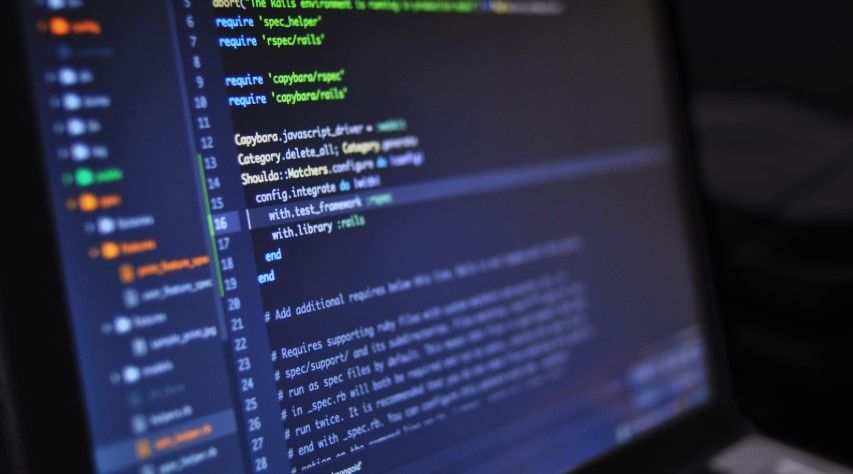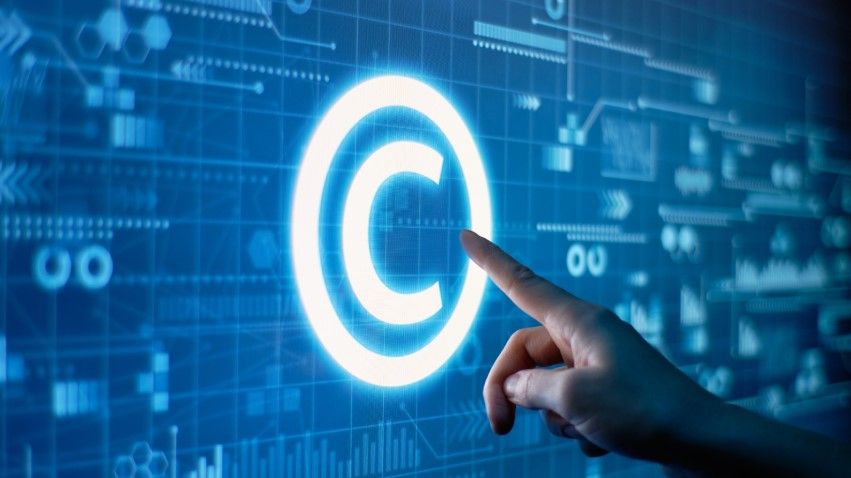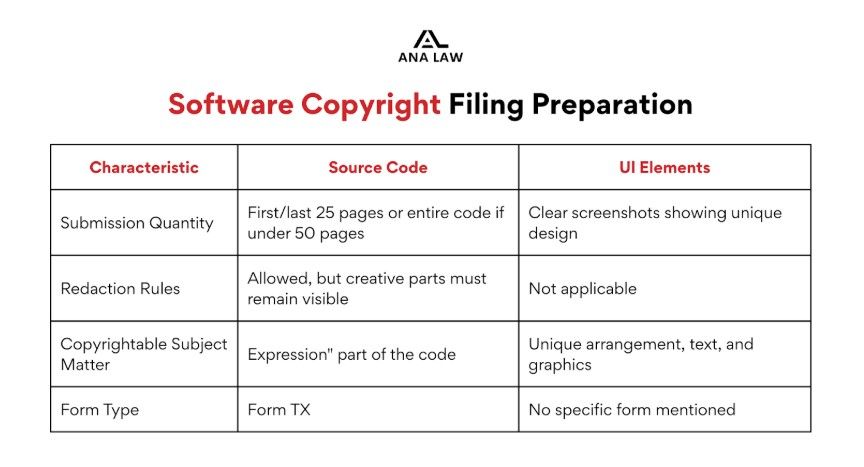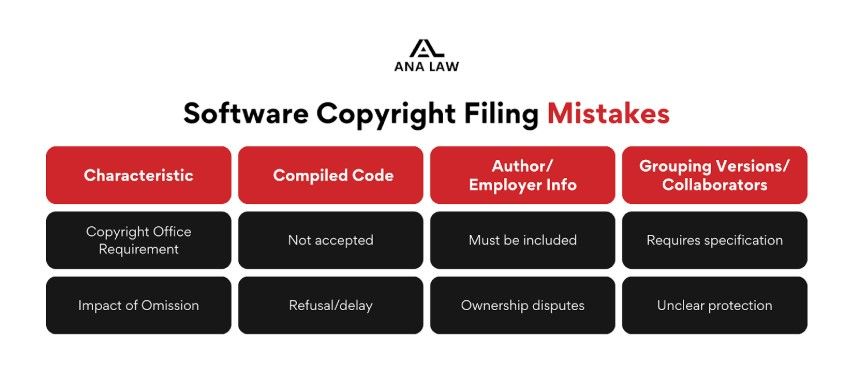

Software developers spend countless hours building unique applications, butdo they also spend time protecting code and user interface (UI) elements?
That’s not always so simple.
Copyright law allows developers to safeguard their original code and design from unauthorized use, but it’s worth knowing what you can and can’t protect.
Code and creative design choices fall under copyright, while ideas, methods, or basic functionality don’t.
Knowing thesteps for copyright registration helps developers avoid common mistakes. As a result, their work stands a much better chance of staying protected.
Understandingcopyright basics lets you make smarter choices for yourself and your projects. For tips on getting started, check out this copyright protection guide for software applications.

Softwarecopyright protection covers more than just lines of code. It can also reach visual designs, layouts, and written materials that are original and meet copyright standards.
Copyright law treats both front-end and back-end source code as “literary works” in most legal systems.
So, code for websites, mobile apps, and software products is automatically protected when it is original and fixed in a tangible form.
You don’t need to register every line of code, but registration makes enforcing rights in a dispute much easier.
Both the structure and sequence of source code are protectable, though not the underlying ideas or algorithms.
If you want to copyright code for your app, you’ll usually have to submit a sample with your application. Copying even parts of a program’s code without permission can land someone in hot water.
Copyright can also cover UI designs—the arrangement of screens, icons, menus, and button styles.
If an app’s look and feel, like a custom color scheme or unique navigation, is original enough, it might qualify for copyright.
People often wonder, “Can I copyright my app UI design?” Well, it depends on how creative it is. Copyright won’t cover basic ideas or standard layouts, but it does protect creative combinations.
UI protection can stop someone from directly copying your app’s visual identity.
Manuals, user guides, online docs, and embedded help files get copyright protection if they’re original. This includes written instructions, screenshots, diagrams, and flowcharts essential to using your software.
Copyright on documentation means others can’t just copy or distribute your written materials without asking. Good documentation is part of your product, even if it’s easy to forget about it.
If you’re submitting acopyright application for a mobile app, it’s smart to include documentation as part of the registration. That extra step can give you more legal coverage.
Are you building something worth protecting? Ana Law helps software developers copyright their source code and UI before launch. Schedule your software filing review today.
If you’re ready to get started, call us now!

Some things in software development just aren’t covered by copyright. Knowing these boundaries helps you figure out when you need other protections and keeps you out of legal gray areas.
Copyright covers how code is written or a UI looks, not the basic ideas, methods, or systems behind them. For example, you can’t copyright the concept of a sorting algorithm or a login flow’s logic.
Only the original expression—like the exact code, graphics, or layout—counts. If someone rewrites code in their style or builds their own interface using the same idea without copying actual content, that’s not an infringement.
Thelaw clearly distinguishes between function and expression in software. Patents—not copyrights—are better for protecting inventions or technical solutions.
If you want to protect how your software works, look intopatents, trade secrets, orlicensing agreements.
| Protected by Copyright | Not Protected |
| Source Code | Functional Logic, Algorithms, Processes |
| UI Layouts | Basic Ideas and Methods |
| Art/Icons | Mathematical Concepts |
Most software projects use third-party libraries, plugins, or frameworks to save time. Copyright doesn’t let you claim ownership over open-source tools or code you didn’t write.
Your rights depend on the original license for that third-party code.
Using open-source libraries means following each license’s rules. Some licenses require you to share your changes, and some just want credit.
If you ignore those rules, you might face legal trouble or get takedown requests.
You can’t copyright code you didn’t create. Even small bits—copied snippets or tweaked plugins—aren’t yours. A strong open-source software copyright strategy means tracking every bit of outside code and respecting the original terms. That’s how you stay compliant and avoid nasty surprises.

Getting your software materials ready is crucial for a solid copyright application. Developers need to follow specific rules when submitting code and UI elements to the U.S. Copyright Office.
Careful redaction and clear presentation can help you dodge mistakes that slow things down or weaken your protection.
The U.S. Copyright Office asks for a chunk of your source code with the registration. You submit the first and last 25 pages of code for unpublished software. If your code is under 50 pages, you send it all.
Keep line numbers in place, and include comments if they’re part of the code. TheCopyright Registration of Computer Programs guide (Circular 61) has all the details.
The office just wants the “expression” part of your program, not the whole program. Use Form TX for literary works like software code.
Some source code contains trade secrets or confidential information. The Copyright Office lets you redact (black out) parts of the code, but you have to leave enough visible so the creative parts are clear.
You can redact variable names, proprietary algorithms, passwords, and sensitive comments. Just make sure the code’s structure and flow are still obvious. If you go overboard, they might refuse or delay your application.
Copyright isn’t just about code. UI elements—icons, menus, layouts—can be registered, too. To protect these, submit clear screenshots with your application.
Grab images showing your app’s unique arrangement, text, and graphics. Screenshots should be unedited and cover different UI parts for a complete picture.
Group them in a single PDF to make things easier. Submitting screenshots is a key step for protecting both code and UI.
Picking the right copyright application matters. Legal protection for source code, updates, and UI design can vary a lot, so it’s worth understanding your options.
Developers use Form TX to register copyright for written material, including software source code. This is the main way to protect your app’s underlying code files, scripts, or other programming work.
You can cover complete programs or just code snippets. But remember, registration only protects the way your code is written and arranged, not how it works or the ideas behind it.
You can attach screenshots to your Form TX application to protect its creative layout or UI design.
Software updates happen constantly, but filing a new application for every tweak is a pain. The U.S. Copyright Office lets you use Group Registration to cover batches of related updates or versions in one go.
This saves time and money, especially for projects with regular releases. Group registration works for updates released in a set window or as part of a versioned series, and it covers both updated code and new UI, if the same author or team made them.
Major releases still need separate registration if they’re launched independently. Using group registration for updates is one of the best ways to protect software legally when it constantly changes.
Copyright protects how software is written or looks, not its actual function or unique method.
A software patent might offer better protection if an app’s value comes from a new algorithm, process, or inventive feature.
Patents can cover specific methods or technical solutions, while copyrights can’t. However, patents cost more, are harder to get, and you must disclose your invention publicly.
Trade secrets give you another option. If you never publicly share the code or method, strict trade secret rules can protect it.
Copyright covers how things look in UI design, but sometimes,design patents offer stronger protection for truly original designs.
Your app deserves more than a terms-of-use page. Ana Law files strategic copyright claims that safeguard both your code and design. Book your call with a legal team that gets tech.
If you’re ready to get started, call us now!

Filing for software copyright isn’t always straightforward. Developers who miss key details that the United States Copyright Office expects can face delays or even lose protection, which nobody wants, especially if it sparksownership disputes.
One big mistake is submitting only the compiled or executable code. The Copyright Office wants the source code, not just machine-readable binaries.
The source code shows the original logic, structure, and the programmer’s creative choices. Executable files, on the other hand, are tough to review and hide those creative decisions.
When developers file with compiled code, examiners can’t see what’s eligible for copyright. That can lead to a refusal or a request for new documentation.
Proper registration means sharing clear, readable source code — usually the first and last parts of the file, or whatever the office asks for. If you’re unsure, double-check what the Copyright Office accepts before applying.
Many people are irritated by the lack of author names or employer details. Every contributor to the code or UI should be listed.
If you worked for a company, the employer usually owns the copyright under the “work for hire” rule. Forgetting this info can lead to headaches later if someone challenges ownership or wants to transfer rights.
Good records show who made the software, strengthening legal protection. Written agreements matter much more than spoken promises for proving copyright ownership in software development.
Overlooking this step can cause problems when selling or buying software since unclear ownership makes contracts risky.
Developers often try registering several software versions simultaneously, especially after many updates. This can get messy fast, making it unclear what’s protected.
The Copyright Office usually asks you to specify each version or explain what’s changed since the last filing.
If several people worked on the software, their individual contributions should be separated. Each listing should show who did what part of the code or UI.
When everything is lumped together, some sections might not be covered. Careful documentation during registration helps avoid confusion later about who owns which features or updates.
Protecting software means a lot more than just saving your code somewhere safe. Developers really need to know how copyright works for program logic, UI elements, and graphic assets—it’s not always obvious where those lines are drawn.
If you are registering a sample software copyright, keep your documentation clear and organized. Gather your codebase, design files, and write descriptions of your user interfaces.
Companies and solo developers should use straightforward contributor agreements. Keeping detailed version histories isn’t just good practice—it can save you a headache if things ever get messy.
Proactive steps make a real difference. Registering your work’s functional and visual sides helps protect your effort and creativity. Why leave it to chance?
From code to interface, Ana Law helps software creators file proper copyright applications that protect their product from copycats and infringement. Contact us to file your software today.
Can copyright protect software code?
Yes. Copyright protects the expression of code, such as structure, syntax, and comments, not its functionality. Source code is treated as a literary work under U.S. copyright law.
What part of my software can be copyrighted?
You can copyright source code, user interface (UI) elements, documentation, help files, and original screen designs. However, functional logic and algorithms are not protected.
How do I file a copyright for software?
Use Form TX via the eCO system, upload a redacted source code file (first 25 and last 25 pages), and optionally include annotated UI screenshots.
Should I register source code or compiled code?
Always register the source code. Compiled code (e.g., executables or binaries) is not readable and cannot be reviewed by the Copyright Office.
How do I protect my app’s UI design?
Submit screenshots with annotations highlighting creative elements like layout, color, and styling. If your GUI is original and non-functional, it may qualify for copyright protection.
Can I register updates or multiple versions of my software together?
Yes, if they meet the group registration criteria. To protect software updates in batches, use options like GRSE or GRTX.
Do I need a lawyer to file a software copyright application?
While not required, an attorney can help ensure your submission is valid, properly redacted, and strategically filed to protect code, UI, and ownership rights.
Across the country and around the globe, business leaders and innovators look to Ana Law as their trusted legal advisor for excellence, innovation, and superior results.
As you look for opportunities to expand and grow your business and revenue, Ana Law is here to help every step of the way. We provide actionable legal & business advice to protect your ideas, products, brands, and revenue.
© Copyright 2025, Ana Law LLC. All Rights Reserved. Privacy Policy | Terms of Use